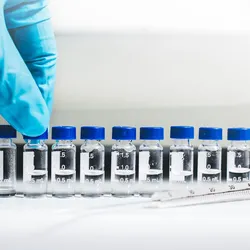
CURRENT ISSUE | VOLUME 7 - ISSUE 7 | August 2012
COVER STORY
2012/2013 Product Resource Guide
Your go-to source for technology trends and analysis, product offerings and manufacturer listing
Lab Product

Pharmaceutical and polymer industries are increasingly interested in both TGA (thermogravimetric analysis) and DSC (differential scanning calorimetry).

Microplate readers are widely used in research, drug discovery, bioassay validation, QC, and manufacturing processes for the detection of biological, chemical, or physical processes in samples contained in microtiter plates.

Power supplies provide steady, precisely controlled electrical energy to electronic equipment. Anyone who has built or worked with a desktop computer recognizes the power supply— typically the bulkiest component—sitting behind the electrical inlet socket.

Low-temperature laboratory freezers will achieve temperatures of -40°C to -85°C, much lower than their kitchen-based counterparts.

Time-of-flight (TOF) mass spectrometry (MS) works by imparting equal energies to all fragments. Since smaller particles thereby travel faster, their masses are determined by how quickly they travel from the source to the detector.

In HPLC columns, reverse-phase and normal-phase chromatography separation methods are based on polarity. Reverse phase columns separate analytes based on their hydrophobicity, with the more hydrophobic compounds being retained longer on the column.

Centrifuges separate particles and structures suspended in liquid by applying thousands of gravitational force equivalents to the sample through spinning. Laboratories use centrifuges to clarify suspensions, separate liquids, isolate suspended particles, perform density measurements and for many other applications.

Water baths are used in industrial and clinical laboratories, academic facilities, government research laboratories, environmental applications, as well as food technology and wastewater plants. Chillers, on the other hand, are refrigerators that cool down samples or processes to preset temperatures.

Gas chromatography-mass spectrometry (GC-MS) is the fastest-growing GC method. Mass detection, which can take a variety of forms based on the MS component, provides a dimension that conventional thermal conductivity or flame ionization detectors cannot.

The right chromatography data system (CDS) can spell the difference between a streamlined data collection process and one that is haphazard. CDSs are software packages that collect, store, and help users interpret data. Some have instrument control functions as well. CDSs come in many different varieties, which can make selecting one a daunting exercise.
White Papers and Application Notes

Although gold nanoparticle production can be controlled to yield specific size ranges, both the concentration and size of nanoparticles must be checked following production.
Products in Action

It is a common misconception that a bath with a larger reservoir provides greater stability because the addition of heat energy results in a smaller temperature rise, iving it the appearance of better stability than a smaller reservoir. To achieve temperature stability, heat must be accurately removed at the same rate as it is added.

BINDER Inc. offers a range of environmental simulation equipment that provides consistent performance – a quality that allows a focus on the research at hand and confidence in the equipment holding samples.

ELGA’s new innovative Type I ultrapure water purification system ensures accurate consistent results. The PURELAB flex 3 & 4 are the latest additions to the award winning PURELAB flex range of systems.

The BRAND Titrette® is the world’s first bottletop burette to provide titration within ASTM and ISO error limits for Class A glass burettes.






















